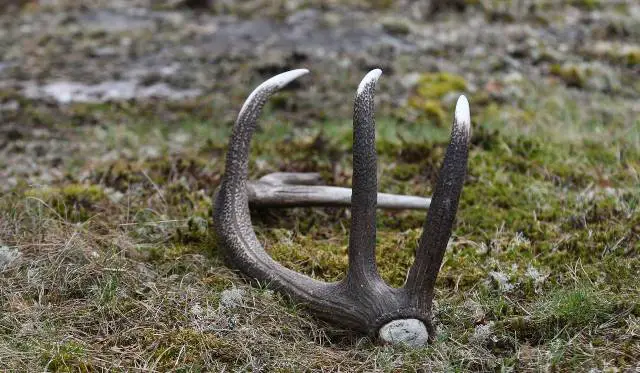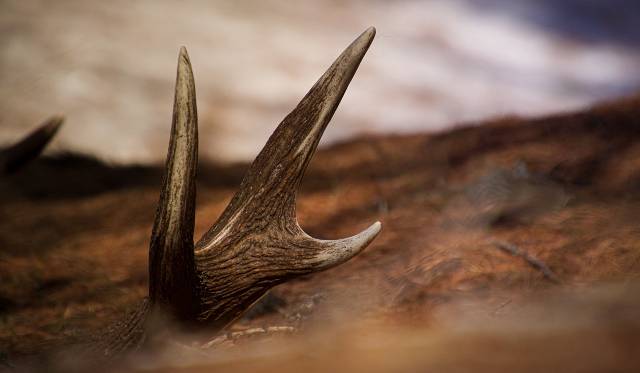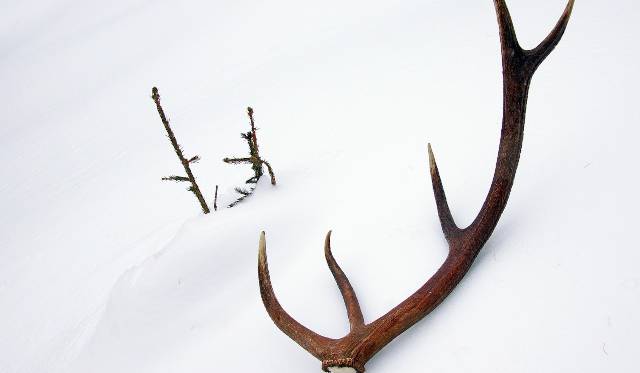Shed hunting is a popular outdoor activity that involves searching for antlers that are naturally shed during late winter and early spring. These antlers can be valuable for various purposes, such as selling, crafting, or simply collecting as unique trophies.
Not only is shed hunting an enjoyable way to spend time outdoors, but it also provides valuable insights into the local deer, elk, and moose populations and their habitat patterns, which can enhance your hunting skills during the shed season.

To be successful in shed antler hunting, you’ll need to understand the antler shedding cycle, and the factors influencing when and where you might find sheds in the landscape. This may vary depending on your location, geography, and the specific species you’re targeting. Additionally, carefully planned trips, appropriate gear, and even training your dog can all significantly improve your chances of finding shed antlers during your excursions.
Contents
- What is Shed Hunting
- Deer Antlers Shedding Process
- Why Do Male Deer, Elk and Moose Shed Their Antlers
- Best Time To Go Shed Hunting
- Understanding the Purpose of Shed Hunts
- Shed Hunting Seasons by Region
- Shed Hunting Trips
- Essential Shed Hunting Gear
- Training Your Dog for Shed Hunting
- Shed Hunting Laws and Regulations
- Final Thoughts: Shed Hunt
- Shed Hunters: Frequently Asked Questions
- Related Articles:
What is Shed Hunting
Shed hunting is an outdoor activity where you search for and collect naturally shed antlers from deer and other antlered animals.
Deer Antlers Shedding Process
Antler shedding is a natural process that occurs in deer, elk, moose, and other antlered animals each year. Antlers break down and fall off of the animal.
Why Do Male Deer, Elk and Moose Shed Their Antlers
Antler growth and shedding are regulated by changes in daylight hours and testosterone levels in the animals. Following the breeding season, testosterone levels drop, triggering the process of antler shedding. This helps the animals conserve energy during winter months when food might be scarce.
Osteoclasts, the cells responsible for breaking down antlers, starts decaying antlers near the pedicle base. Shedding old antlers allows for the growth of new, larger ones for the upcoming breeding season. Osteoblasts help generate new replacement antler tissue.
Best Time To Go Shed Hunting
In most regions, bucks begin shedding their antlers in late winter, typically around January or February. However, this may vary depending on a few factors such as individual deer characteristics, stressors, and regional weather conditions. Shedding is a gradual process, and if you’re out exploring the woods during this time, you might come across antler sheds on the ground.
Understanding the Purpose of Shed Hunts
One of the main reasons people engage in a shed hunt is to better understand deer behavior and movements. When you spend time looking for sheds, you will begin to notice patterns in where deer have dropped their antlers.
This knowledge can be useful to enhance your deer hunting skills, as it helps you become familiar with the routes and locations that deer frequent. Shed hunters can observe deer sign and piece together valuable information about their habits.
A hunt for antlers also provides an opportunity to scout new land, either for future hunting tips or general outdoor exploration. As you venture into new areas in search of sheds, you might discover hidden pockets of land that hold potential for future hunts.
Additionally, some shed hunters collect antlers to sell them or use them for tools or craft projects, allowing them to combine both their passion for the outdoors with a potential income stream. Learn more about deer antler grade and value.
Shed Hunting Seasons by Region
Shed antler hunting is a more accessible option for many hunters, as deer antler sheds, elk antlers, and moose antlers can be found in a wide variety of locations.
Midwest
In the Midwest, the best time to go antler hunting is typically between mid-December and mid-March. Depending on the weather, these dates can vary, but in most years, the post-rut period offers prime opportunities for finding antlers from the various deer species in this region. As the snow melts, plan on being in the woods and walking the terrain.
Northwest
The vast terrain and diverse landscape offer numerous opportunities for finding antlers from deer, elk, and other antlered animals. The best time period to shed hunt for antlers in the northwest is typically from late winter to early spring, which is usually from mid-January to April.
Remember to adhere to any regulations or restrictions that may be in place regarding shed hunts in your specific area.
Southwest
In the arid region of the Southwest, shed hunting usually starts in late February or early March. The diverse mix of desert, mountain, and grassland habitats provides ample opportunities for discovering antlers from mule deer, elk, and other species.
Keep in mind that the harsh desert environments can make this form of hunting more challenging, so be prepared with proper clothing, hydration, and essential gear.
Northeast
The Northeast shed hunting season generally occurs around the same time as the Midwest — between late-December and mid-March.
The region’s colder climates and harsher winters can affect the timing of when antlers are shed, but as soon as the snow melts, you should be ready to hit the trails in search of deer, moose, and bull elk sheds.
Southeast
In the Southeast, shed hunting season begins slightly earlier than in the Northern regions, often starting in late January or early February. Warmer weather and earlier breeding seasons contribute to the different shedding times for deer and elk in this region.
Be prepared to search through the thick underbrush and swamps for antler drops from the various antlered animals living in the southeastern United States.
How To Find Shed Antlers: Shed Hunting Tips
In order to maximize your chances of finding sheds, consider employing these strategies:
- Focus on areas where deer are likely to be during the shedding season, such as bedding areas, food sources, and travel corridors. Remember that deer are creatures of habit and will often use the same paths and bedding locations year after year.
- Use binoculars to scan larger areas quickly, and then concentrate your efforts on potential hotspots.
- Observe local deer populations and pay attention to their movements, which can lead you to high-potential shedding areas.
- Start slow and work methodically, giving yourself time to process the landscape and spot antlers.
- Always keep up to date with any regulations or restrictions in your area before setting off on your antler hunting expedition. Keep in mind that ethical hunting is essential to preserve the environment and minimize disturbance to wildlife.

Shed Hunting Trips
Whether you’re a seasoned shed hunter or a beginner, planning a shed hunting trip can be an enjoyable and rewarding experience. There are various types of shed hunting trips, including elk shed hunting trips, guided shed hunting trips, and utilizing shed hunting outfitters.
Essential Shed Hunting Gear
Increase your chances of success by having the right gear to enhance your trip. By equipping yourself with these essential items, you’ll be well-prepared for a successful antler hunting trip.
- Hiking Boots: First and foremost, invest in a good pair of hiking boots for comfort and support while walking long distances. These boots should be durable, waterproof, and offer good ankle support to prevent injuries.
- Appropriate Clothing: Wearing appropriate clothing is crucial for protection against varying weather conditions. Layering is key, as temperatures can fluctuate throughout the day. Wear moisture-wicking base layers, followed by insulating mid-layers, and finally, a waterproof outer layer.
- Backpack: Don’t forget to bring along a reliable backpack to carry your gear and any sheds you find. Opt for a backpack with multiple compartments for organization and easy access to your essentials.
- Binoculars: Visibility is important, so investing in a quality pair of binoculars or a spotting scope can make a world of difference. These will allow you to scan the area from a distance and detect sheds more effectively.
- GPS Device: A GPS device can be incredibly helpful for navigating unfamiliar terrain and marking your finds’ locations. Many GPS models also allow you to track your path, which can be useful for ensuring you don’t retrace your steps.
- Water and Food: Bring plenty of water and snacks to stay energized and hydrated throughout your expedition. A water bottle outfitted with a built-in filter can be convenient for refilling from natural sources if necessary.
- Gloves: Don’t forget a sturdy pair of gloves to protect your hands when handling antlers. Gloves with reinforced palms and fingers will provide added durability and grip.
Training Your Dog for Shed Hunting
Training your dog for shed hunting can be both fun and rewarding. It helps reinforce your dog’s natural retrieval skills and keeps them active during the winter months. Here’s how you can get started.
First, it’s essential to begin with basic obedience training. Your dog should be start by following simple commands like sit, stay, and come. This will help ensure your dog remains focused and disciplined while hunting for sheds.
When introducing your dog to shed hunting, start by introducing them to the scent of antlers. You can do this by allowing your dog to smell and play with a shed antler. Initially, let your dog play with the antler in a controlled environment to help build a positive association with the activity.
Next, begin hiding the antler in a small, controlled area, such as your backyard. Encourage your dog to search for the antler using their sense of smell. Praise and reward your dog when they locate the antler, as this will help reinforce the behavior.
Gradually increase the difficulty of the search by hiding the antler in more challenging locations and expanding the search area. This will help build your dog’s confidence and ability to find shed antlers in various environments.
Consistency is key throughout the training process. Aim to practice antler hunting with your dog for a few minutes each day, and be patient as they learn and become proficient in seeking out antlers.
Keep in mind that this type of training can last four to six weeks or longer depending on the frequency and consistency of your training sessions.
Remember to always be patient and positive with your dog during the training process to start shed hunting.
Shed Hunting Laws and Regulations
Be aware of the laws and regulations that apply to your location. In general, shed hunting regulations vary from state to state, so always check the specific regulations for the area where you plan to hunt.
One crucial aspect of shed hunt regulations is the timing of the season. Many states have laws that prohibit the activity during certain times of the year to protect wildlife, particularly during their vulnerable winter months.
For example, in several western states, shed antler hunting is not allowed on public land from January 1 through April 30. In some states, possessing shed antlers during the closed period can be a serious offense.
Most states have laws regulating the collection and possession of these antlers. To make sure you’re following the right guidelines, check if you need any permits or written permission from landowners before you begin your hunt.
In some cases, you might be required to take an antler gathering course or obtain a certificate before you can legally collect antlers. For example, Utah’s antler gathering course.
While searching for shed antlers, remember to always respect private property and follow all posted signs and warnings. Always follow any rules and regulations set by landowners or government agencies, such as seasonal restrictions and permit requirements.
If you’re unsure about the regulations in your area, it’s a good idea to contact your local wildlife agency for information and clarification.

Final Thoughts: Shed Hunt
Antler shedding is an essential part of deer biology and offers unique insights into the lives of these animals. As you explore during your shed hunt, remember that respecting the natural environment and wildlife is crucial for maintaining a healthy ecosystem and ensuring the continuation of this fascinating outdoor activity.
By exploring the world of shed antler hunting, you have the opportunity to deepen your connection with nature, enhance your deer hunting skills, stay active, and potentially even create unique tools, pieces of art or earn extra income. So, grab your gear and head out into the woods!
Shed Hunters: Frequently Asked Questions
Is shed hunting legal?
Yes, shed hunting is generally legal but regulations vary depending on the location and the type of antlered animals. It is essential to check your local regulations before going out to ensure that you’re compliant with all rules in your area.
How much are deer sheds worth?
The value of deer sheds can vary greatly depending on size, quality, and rarity. In general, the value of various deer antlers can be worth anywhere from a few dollars to several hundreds of dollars. Keep in mind that supply and demand can also affect the prices.
What time of year do bucks shed their antlers?
Bucks shed their antlers typically in late winter or the beginning of spring. However, the exact time frame can vary regionally, so it’s important to research the best times for antler hunting in your specific state or region.
How to find deer sheds?
Deer sheds can be located where deer are commonly found. Focus on areas with high deer traffic, such as feeding and bedding areas. Look for natural funnels, edges of fields, or places where deer jump over obstacles. Patience, persistence, and attention to detail can help you find more shed antlers.
When do deer shed their antlers regionally?
Deer typically shed their antlers from late winter to early spring, although the exact timing can vary depending on factors such as climate, habitat, and individual deer characteristics. In general, the further north you are, the earlier deer tend to shed their antlers.
What are popular elk shed hunting trips?
Elk shed hunting trips are popular in western states such as Colorado, Wyoming, Utah, and Montana. Similar to deer shed hunting, the best time to hunt sheds is when elk shed their antlers, which can be around April to June depending on the region.
Where to go shed hunting?
You can shed hunt wherever deer are commonly found as long as you are abiding by hunting laws and regulations.
Can you take shed antlers from a national park?
No, it is typically illegal to remove shed antlers from national parks. Rules and regulations vary among national parks, forests, and public lands; it is important to check with the specific park you are visiting and follow their guidelines to ensure that their ecosystem is protected.